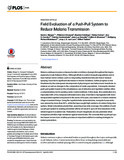Field Evaluation of a Push-Pull System to Reduce Malaria Transmission

View/
Date
2015Author
Takken, Willem
Loon, Joop J A van
Wolfgang, Richard M
Mweresa, Collins K
Derycke, Jean-Luc
Vandendaele, Patrice
Carreira, Ana S
Homan, Tobias
Holdinga, Maarten
Omusula, Philemon
Menger, David J
Language
enMetadata
Show full item recordAbstract
Malaria continues to place a disease burden on millions of people throughout the tropics, especially in sub-Saharan Africa. Although efforts to control mosquito populations and reduce human-vector contact, such as long-lasting insecticidal nets and indoor residual spraying, have led to significant decreases in malaria incidence, further progress is now threatened by the widespread development of physiological and behavioural insecticide-resistance as well as changes in the composition of vector populations. A mosquito-directed push-pull system based on the simultaneous use of attractive and repellent volatiles offers a complementary tool to existing vector-control methods. In this study, the combination of a trap baited with a five-compound attractant and a strip of net-fabric impregnated with micro-encapsulated repellent and placed in the eaves of houses, was tested in a malaria-endemic village in western Kenya. Using the repellent delta-undecalactone, mosquito house entry was reduced by more than 50%, while the traps caught high numbers of outdoor flying mosquitoes. Model simulations predict that, assuming area-wide coverage, the addition of such a push-pull system to existing prevention efforts will result in up to 20-fold reductions in the entomological inoculation rate. Reductions of such magnitude are also predicted when mosquitoes exhibit a high resistance against insecticides. We conclude that a push-pull system based on non-toxic volatiles provides an important addition to existing strategies for malaria prevention.
URI
http://journals.plos.org/plosone/article?id=10.1371/journal.pone.0123415http://hdl.handle.net/11295/85067
